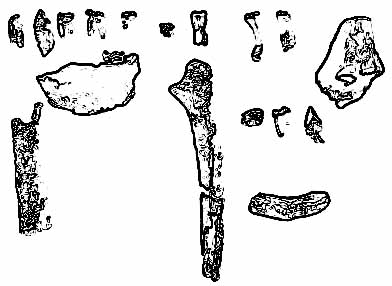- Ardipithecus
Taxobox
name = "Ardipithecus"
fossil_range =Pliocene

image_caption = "Ardipithecus kadabba" fossils
regnum =Animal ia
phylum = Chordata
classis =Mammal ia
ordo =Primate s
familia =Hominidae
subfamilia =Homininae
tribus =Hominini
genus = "Ardipithecus"
genus_authority = White et al., 1995
subdivision_ranks =Species
subdivision = †"Ardipithecus kadabba "
†"Ardipithecus ramidus ""Ardipithecus" is a very early hominin
genus (subfamily Homininae ) which lived about 4.4 million years ago during the earlyPliocene .Because this genus shares several traits with the African
great ape genera (genus "Pan" and genus "Gorilla "), it is considered by some to be on thechimpanzee rather thanhuman branch, but most consider it aproto-human because of a likeness in teeth with "Australopithecus ".Species
Two
species have been described, "Ardipithecus ramidus" and "Ardipithecus kadabba", which was initially described as asubspecies of "A. ramidus", but on the basis of teeth recently discovered inEthiopia has been raised to species rank. Remains from both species have been found in theMiddle Awash .Ardipithecus ramidus
"A. ramidus" was named in September 1994. The first fossil find was dated to 4.4 million years ago based on its interval between two volcanic strata: the basal Gaala Tuff Complex (GATC) and the Daam Aatu Basaltic Tuff (DABT). Subsequent fossil discoveries by
Yohannes Haile-Selassie andGiday WoldeGabriel —if identified as "A. ramidus"—would push the date back as far as 5.8 million years ago. [cite web | author = Perlman, David | date = 2001-07-12 | title = Fossils From Ethiopia May Be Earliest Human Ancestor | work = San Francisco Chronicle, as reported in National Geographic News | url = http://news.nationalgeographic.com/news/2001/07/0712_ethiopianbones.html]In 1992-1993 a research team headed by Dr Timothy White discovered the first "A. ramidus" fossils—seventeen fragments including skull, mandible, teeth and arm bones—from the
Afar Depression in theMiddle Awash river valley ofEthiopia . More fragments were recovered in 1994, amounting to 45 percent of the total skeleton. Features of theforamen magnum and leg fragments are indicative ofbipedalism . [cite web | title = Ardipithecus ramidus | url = http://www.archaeologyinfo.com/ardipithecusramidus.htm | accessdate = 2008-01-18] [cite web | url = http://www.talkorigins.org/faqs/homs/species.html | title = Hominid Species | accessdate = 2008-01-18]Ardipithecus kadabba
"A. kadabba" is dated to have lived between 5.8 million to 5.2 million years ago. The
canine teeth show primitive features, shared with "Sahelanthropus " and "Orrorin ", that distinguish them from those of more recenthominin s. It has been suggested that "A. kadabba" is the most recent common ancestor of "Homo" and "Pan". Anthropologists Yohannes Haile-Selassie, Gen Suwa, and Tim D. White published an article suggesting that the presence of a "canine cutting complex" indicates a need for relocation in hominid evolutionary history. [cite journal |last=Haile-Selassie |first=Yohannes |authorlink= |coauthors=Suwa, Gen; White, Tim D. |year=2004 |month= |title=Late Miocene Teeth from Middle Awash, Ethiopia, and Early Hominid Dental Evolution |journal=Science |volume=303 |issue=5663 |pages=1503–1505 |doi=10.1126/science.1092978 |url= |quote=|pmid=15001775 ] Since "A. ramidus" is lacking the canine cutting complex, the authors argue, it is reasonable to infer the canine cutting complex, which is present in modern day chimpanzees, is a primitive trait which was lost during hominin evolution. The specific name comes from theAfar word for "basal family ancestor".cite book| last = Ellis| first = Richard| authorlink = Richard Ellis (biologist) | title = No Turning Back: The Life and Death of Animal Species| publisher = Harper Perennial | date = 2004| location = New York| pages = 92| isbn =0-06-055804-0 ]Lifestyle
On the basis of bone sizes, "Ardipithecus" species are believed to have been about the size of a modern chimpanzee.
The toe structure of "A. ramidus" suggests that the creature walked upright, and this poses problems for current theories of the origins of hominid
bipedalism : "Ardipithecus" is believed to have lived in shady forests rather than on the savannah, where the more energy efficient locomotion permitted by bipedalism would have been an advantage.References
External links
* [http://news.bbc.co.uk/2/hi/science/nature/4187991.stm BBC News: Amazing hominid haul in Ethiopia]
* [http://www.nytimes.com/2006/05/18/science/18evolve.html?pagewanted=2&_r=1 NY Times: Two Splits Between Human and Chimp Lines Suggested]
* [http://www.mnsu.edu/emuseum/biology/humanevolution/ramidus.htm Minnesota State University]
* [http://www.archaeologyinfo.com/ardipithecusramidus.htm Archaeology info]
Wikimedia Foundation. 2010.
